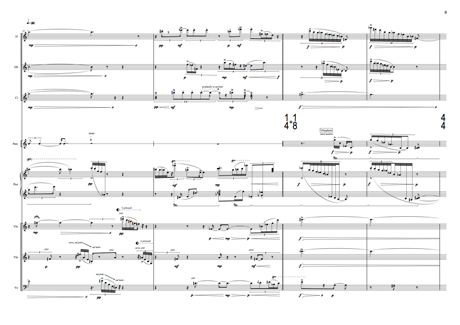A further definition might be of a space as a discrete object amongst a constellation of other objects. Each space would have its own internal spatial geometry, containing idiosyncratic features and connections – much like a house, surrounded by other houses, streets, areas and a city. Each building would be distinct from another (externally and internally), with the conglomerate presenting a sometimes chaotic, but not necessarily disorderly, overall image. Here, the word ‘distance’ might additionally be used to evoke an ideological difference. Each object in space could therefore be said to demonstrate degrees of remoteness, as defined by their actual physical separation, but also by their differing anatomy and logic. Yet, within this perceptual space, one might begin to draw connections between these various objects in order to reveal unseen pathways and to find common ground beneath disparate philosophies.
This piece proposes five objects, each formed from diverse means. From a scored manuscript, to a sound collage, to a poetic reference: five ideologically distinct spaces. These are thought of as forming a virtual constellation – a visual abstraction whose objects exhibit gravitational forces, auras, light deflection, and interact with each other and the background in various dynamic ways. The piece becomes one journey – of many possible journeys – through this constellation of objects: the composition, a view through a camera lens. When we are close, we see details of the objects clearly; when further away, they are more diffuse, fused with other materials, degraded.
The path around these objects loops forward and back through familiar space – this déjà and presque vu affording angles that reveal new details of the objects with particular reference to their place in the constellation. By the nature of this narrative unfolding, connections are drawn in order to find commonalities – to discover wholeness from difference. In Jaccottet’s ‘Distances’, where ‘swifts turn in the heights of the air’, the fire of the stars continue to shine at the end of each day against the ‘dark expanse of sand’ of our worldly issues. But the heart is able to transcend the scales of reality. “From tree, to bird, from bird to distant star”: the perspective of distance negating difference and atomisation – championing inclusivity.
